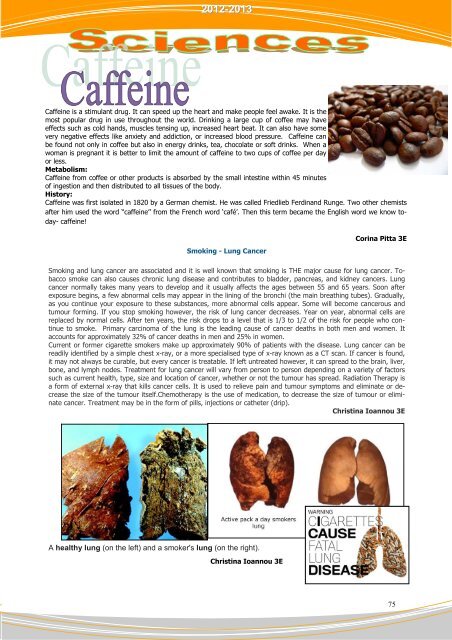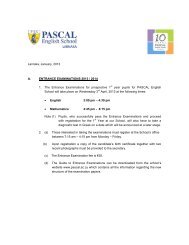Chronicle
The PASCAL Chronicle 2012-13 - Pascal Education
The PASCAL Chronicle 2012-13 - Pascal Education
You also want an ePaper? Increase the reach of your titles
YUMPU automatically turns print PDFs into web optimized ePapers that Google loves.
2012-20132013Caffeine is a stimulant drug. It can speed up the heart and make people feel awake. It is themost popular drug in use throughout the world. Drinking a large cup of coffee may haveeffects such as cold hands, muscles tensing up, increased heart beat. It can also have somevery negative effects like anxiety and addiction, or increased blood pressure. Caffeine canbe found not only in coffee but also in energy drinks, tea, chocolate or soft drinks. When awoman is pregnant it is better to limit the amount of caffeine to two cups of coffee per dayor less.Metabolism:Caffeine from coffee or other products is absorbed by the small intestine within 45 minutesof ingestion and then distributed to all tissues of the body.History:Caffeine was first isolated in 1820 by a German chemist. He was called Friedlieb Ferdinand Runge. Two other chemistsafter him used the word “caffeine’’ from the French word ‘café’. Then this term became the English word we know today-caffeine!Smoking - Lung CancerCorina Pitta 3ESmoking and lung cancer are associated and it is well known that smoking is THE major cause for lung cancer. Tobaccosmoke can also causes chronic lung disease and contributes to bladder, pancreas, and kidney cancers. Lungcancer normally takes many years to develop and it usually affects the ages between 55 and 65 years. Soon afterexposure begins, a few abnormal cells may appear in the lining of the bronchi (the main breathing tubes). Gradually,as you continue your exposure to these substances, more abnormal cells appear. Some will become cancerous andtumour forming. If you stop smoking however, the risk of lung cancer decreases. Year on year, abnormal cells arereplaced by normal cells. After ten years, the risk drops to a level that is 1/3 to 1/2 of the risk for people who continueto smoke. Primary carcinoma of the lung is the leading cause of cancer deaths in both men and women. Itaccounts for approximately 32% of cancer deaths in men and 25% in women.Current or former cigarette smokers make up approximately 90% of patients with the disease. Lung cancer can bereadily identified by a simple chest x-ray, or a more specialised type of x-ray known as a CT scan. If cancer is found,it may not always be curable, but every cancer is treatable. If left untreated however, it can spread to the brain, liver,bone, and lymph nodes. Treatment for lung cancer will vary from person to person depending on a variety of factorssuch as current health, type, size and location of cancer, whether or not the tumour has spread. Radiation Therapy isa form of external x-ray that kills cancer cells. It is used to relieve pain and tumour symptoms and eliminate or decreasethe size of the tumour itself.Chemotherapy is the use of medication, to decrease the size of tumour or eliminatecancer. Treatment may be in the form of pills, injections or catheter (drip).Christina Ioannou 3EA healthy lung (on the left) and a smoker's lung (on the right).Christina Ioannou 3E75
















